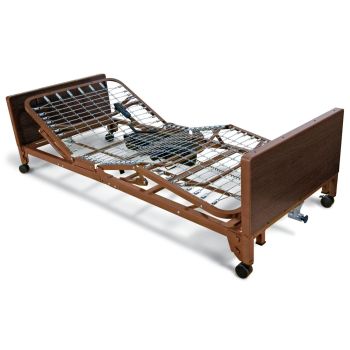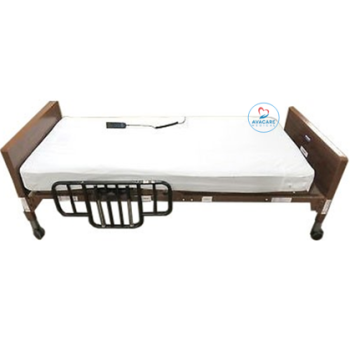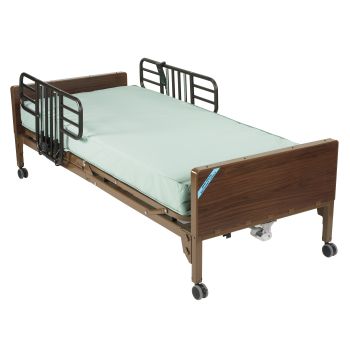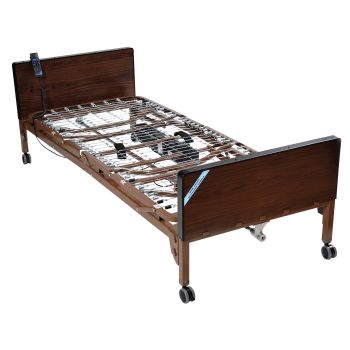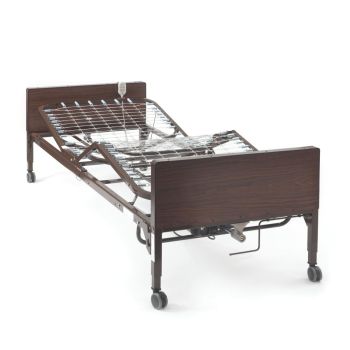Free shipping orders over $50
Hospital Bed Frames / Standard Hospital Bed Size

Hospital bed frames come in all different sizes and styles. Most of our beds meet the standard hospital bed size expectations that are required for postoperative or home care use, and they are similar to those seen in hospitals. If you are in need of a medical bed frame that can help you, you’ve come to the right place! Read more...
-
Medline Semi Electric Basic Bed
Starting at $468.29 -
Medline Full Electric Low Basic Bed
Starting at $692.17 -
Medline Full Electric Bed
Starting at $586.57 -
Delta Ultralight Full-Electric Bed
Starting at $913.45 -
Delta Ultralight Semi-Electric Bed
Starting at $728.79 -
MedLite Bed
Starting at $625.91 -
Invacare Manual Homecare Bed
$518.70
Different Types Have Different Uses
Most people are used to traditional bed frames, and therefore assume choosing a standard hospital bed is just the same. Yet they couldn’t be more wrong. There is more than one type of basic hospital bed for sale on the market, and each type serves different purposes. While all of them can be fully adjusted and provide numerous benefits, each one should be chosen depending on the actual needs of the user or patient. The common types of hospital beds are:
Standard Full Electric Beds
This type of electric bed is a very popular choice simply because of the convenience that it provides to users and caregivers alike. Electronic beds have electric controls (buttons or remotes) that are easily accessible by the caregiver on the bed itself. This allows the head and foot section, as well as the height of the bed overall, to be adjusted as needed. This type of bed is a great choice for those who can transfer out of bed easily or for caregivers who may have difficulty making bed adjustments with manual controls. Most of our fully electric basic hospital beds still have hand controls for emergency scenarios such as power outages.
Standard Semi-Electric Beds
Semi-electric beds are only slightly different from fully electric beds. They often use electronics to adjust the head and foot sections of the beds, but not the height of the bed itself. The height adjustment still needs to be done by a manual hand crank method. This bed proves the perfect choice for those who have a caregiver who can adjust the bed manually. It also allows a patient who has a significant degree of mobility to control the electronics themselves while remaining safe.
Manual Beds
Manual beds are basic hospital beds that are completely operated by physical means – most often by the use of a hand crank. They are usually lightweight as they have no motor, and many people purchase these simply because they often cost less than electric beds. Many times, these beds are the model of choice for those who are immobile and have a caregiver who can do all of the adjustments.
One of the key differences marking a standard bed is that basic beds are often more economical than other long-term care beds. They may have the option to add bed accessories as well as other items such as special mattress covers for incontinence and bodily fluid protection. This represents a similarity between these models and any other hospital bed. Some may even be able to add bed rails if not already installed.
Frequently Asked Questions
We understand that many people have questions regarding these hospital beds, and therefore, we’ve compiled this list to help provide helpful answers for everyone.
Q: How Long is a Standard Hospital Bed?
A: The most common size length of a hospital bed is 80 inches. There are some beds that are longer, and some that can be extended in length by purchasing bed extensions. The length of the bed can be up to 94 inches in some bariatric models.
Q: How Wide is a Standard Hospital Bed?
A: Standard hospital beds are approximately 36 inches wide. However, there are some exceptions when it comes to bariatric models or beds that have extenders on them. Some larger beds may also be purchased, but are often no more than 54 inches wide.
Q: What Size is a Standard Hospital Bed?
A: The average size standard hospital bed only holds a twin sized mattress. Bariatric models and larger beds with up to 54-inch frames can hold up to a full size mattress. Some wonder about the existence of Queen sized and King sized hospital beds. While there are adjustable beds that meet the criteria and can hold these traditional mattress sizes, these are not considered to be home hospital beds (or hospital beds at all), and therefore you won’t find them on AvaCare Medical. Most hospitals use twin-sized beds for pediatric patients and in-stay beds for most adults as well as bariatric individuals.
Q: Do I Need Bed Rails?
A: There has been much debate about the necessity of bed rails on hospital beds. Here at AvaCare medical, we offer beds that have the capability of adding rails as well as models that come with them permanently attached. There are many positive benefits of having a bed with rails. Beds that have arm rails can be used to protect the patient from rolling off the bed and injuring themselves. Those who have trouble getting in and out of bed, and need something to hold onto while doing so will also benefit from using bed rails. Rails aid users with balance and stability support while transferring.
Another thing to note about bed rails is that they can come in two different types. Some bed rails are adjustable, which means that they can be raised and lowered when needed. Others are fixed in position in terms of height and location of the bed. There are also varieties in bedrail types, too – from rails that cover a majority of the bed (also known as full bed rails) to partial rails which only cover a small section of the bed, like the head section for instance. These are meant to protect the user as much as possible while providing the crucial handle that they need as an aid in getting in and out of bed.
At AvaCare Medical, we care about your opinion, and we want you to derive the most possible benefit from the standard hospital bed frames you choose. We know the importance of a standard hospital bed, and therefore, are careful to ensure that all of our medical bed frames are 100% top-quality frames made by the nation’s best and most popular medical equipment providers. If you have any questions or would like assistance with your order, simply call us at 1-877-813-7799, a representative will be honored to assist you!




